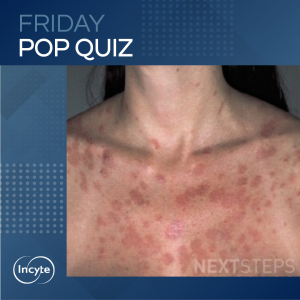
The correct answer is C. Grave’s Disease.
Herpes gestationis (HG) typically occurs in the second or third trimester, and clinically presents as urticarial papules and plaques around the umbilicus which progress to involve the rest of the body. HG has been associated with Grave’s disease. Hormonal factors influence the disease manifestation. This condition can be seen in pregnant women, menstruating women, and women taking oral contraceptives.
Pemphigoid gestationis is an autoimmune blistering disease, which basically means that an individual’s immune system starts reacting against his or her own tissue. Immunoglobulin type G (IgG) autoantibodies (known as the PG factor) cause the damage.
In pemphigoid gestationis, the target is a protein known as BPAG2 (also called BP180), found within the basement membrane, which is the zone between the epidermis and the dermis (the top and middle layers of skin). BPAG2 is within the hemidesmosome, the cell component that sticks the epidermal keratinocyte cells to the dermis.
The antibody attack results in inflammation and separation of the epidermis from the dermis allowing fluid to build up and create a blister.
Most patients present with an intensely itchy hive-like rash during mid to late pregnancy (13 to 40 weeks gestation).
- Initially, there are itchy red bumps around the belly button
- Within days to weeks, the rash spreads to other parts of the body including the trunk, back, buttock, and arms. The face, scalp, palms, soles and mucous membranes are usually not affected.
- After 2-4 weeks, large, tense fluid-filled blisters form
- Some patients may have no blisters but instead, have plaques (large raised patches)
In some cases, pemphigoid gestationis occurs throughout pregnancy. Symptoms may lessen or spontaneously resolve towards the end of the pregnancy but this is short-lived, as 75-80% of women will experience a flare-up around delivery. In most cases, symptoms resolve days later after giving birth, however, in some, the disease remains active for months or years. Commencement of menstrual periods, use of oral contraceptives or further pregnancies may cause flare-ups.
References: Christine Sävervall, Freja Lærke Sand, and Simon Francis Thomsen. Pemphigoid gestationis: current perspectives. Clin Cosmet Investig Dermatol. 2017; 10: 441–449. Published online 2017 Nov 8. doi: 10.2147/CCID.S128144. PMCID: PMC5685197. PMID: 29184427
Brought to you by our brand partner
